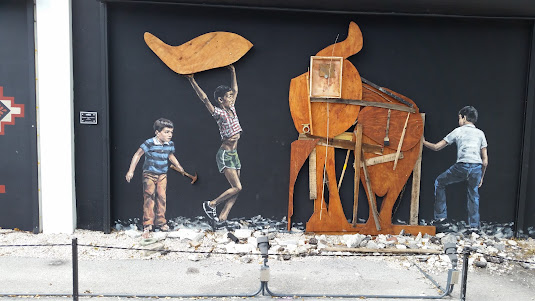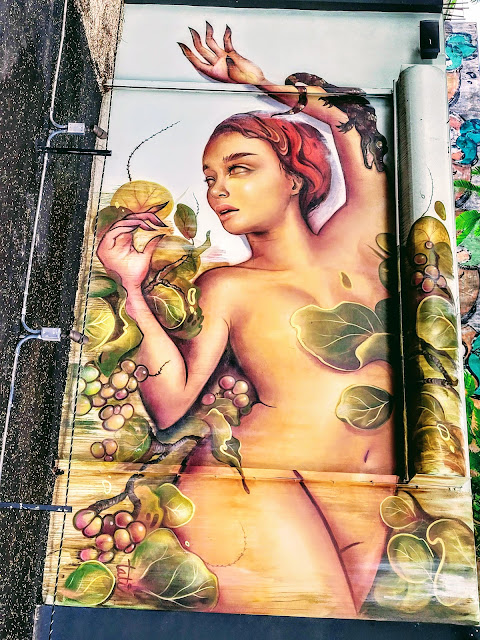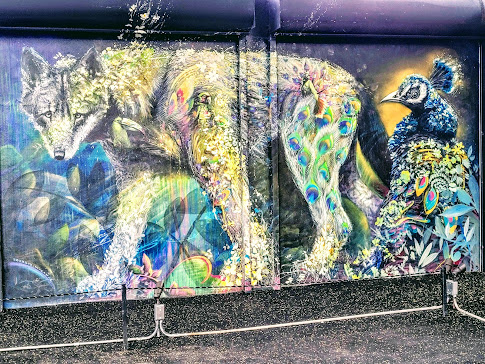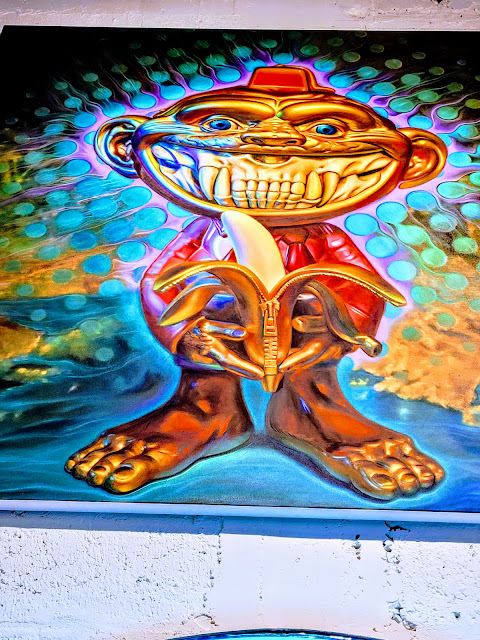Tuesday, February 22, 2022
Cuenca Perspectives by Jim: AUTHENTIC CHICAGO STYLE DEEP DISH PIZZA IN CUENCA,...
AUTHENTIC CHICAGO STYLE DEEP DISH PIZZA IN CUENCA, ECUADOR
If anybody has even tasted Deep Dish Chicago Style Pizza in Chicago, at one of the top deep-dish pizzerias like Gino's East, Uno's, or Lou Malnati's of my generation, back when Deep Dish became the craze in Chicago during the 60's and 70's; they were in for a savory pizza delight unknown to the world at that time. People thought nothing in the coldest Chicago winter nights to wait outside these restaurants in line for 45 minutes to an hour to get a seat, and then wait another hour before the pizza was baked and served. In the last twenty years, folks would stand in line and place their order on some electronic gizmo, and now on their cell phones and have the pizzas about ready by the time they are seated. But back in the good, old days, the rugged baby-boomers would stand out in the freezing, windy Chicago weather just for the honor of having a seat of privilege at the table of exceptionally yearned for deep dish pizza.
Back in these early days of deep-dish mania, there was fierce competition
especially between Uno’s and Gino’s East restaurants in Chi-Town. Everybody had their favorite of the two, much like the rivalry between
the White Sox and the Cubs, and never the twain shall meet. It was amazing
how heated folks could get over which pizzeria had the best deep-dish--Uno's or Gino's East.
Today, whenever I go home to visit family, we always make a trek to the south suburb of Homewood, Illinois, at Aurelio’s which in my opinion has the best deep-dish in the Chicago area. Of course, new places have also sprouted up in recent years, which many millennials prefer, because the younger generations like places that they feel have their stamp of approval. Also, many of the branches are not always up to the quality of the original pizzeria. I had a deep-dish at Unos in Baltimore Harbor a few years ago. It was good, but somehow just wasn't quite the same taste as the original Unos on Ohio Street in Chicago.
Thin crust pizza over the last twenty years has made a come back in Chicago, although it never really disappeared. More people today are weight conscious, and I was surprised to learn that Uno's is dropping deep-dish pizza in all of their restaurants across the nation. The powers that be claim it is too time consuming to make and bake and requires to many ingredients. In other words, they are more concerned with maximizing profit, and moving people along more quickly in their restaurants. American culture is way past the point of having respect for tradition over profits.
Chicago
style deep-dish pizzas are built in the following order: homemade thick crust, hefty amounts of mozzarella cheese, toppings, fresh tomato sauce or tomato slices. Each has its own unique taste, and the crusts can
vary in taste and texture. Gino’s East uses a buttery tasting
crust for example, and the pizzas are furthered custom-made by the choices
customers choose to add.
When deep dish first began in Chicago, before the original outlets would move across the country, sausage had always been the favorite meat on pizzas in the Chicago market. I discovered while a grad student in the late 70's at NYU, that pepperoni was the big favorite, and thin crust was the Big Apple’s style. I never had a pepperoni pizza until I attended school in NYC. Later, pepperoni as a pizza topping became a big choice in Chicago as well. I don’t know what the ratio between pepperoni and sausage choices are in Chicago today.
Another
absolute favorite is Giordano's, which appeared in 1974, and was a quick
favorite of the Deep-Dish Stuffed Pizza crowd.
The stuffed pizza requires two layers of crust. The bottom layer is layered with an ubiquitous
amount of mozzarella cheese from the cheese capital of the U.S.A.—the state of
Wisconsin. Another layer of crust is
added and then the tomato sauce and toppings are added with a sprinkling of
cheese.
Unlike
Ecuador where pizza has rapidly grown in popularity over the last decade. Ecuadorian pizza is thin crust, and often
little if any tomato sauce is used.
Ecuadorians prefer their pizza primarily with cheese, and various meat
and vegetable toppings. A small number
of pizzerias attempted deep dish pizza. A
couple of them even claimed they were serving authentic Chicago style deep-dish
pizza. None of them even came close. Usually the toppings where sparse and the Mozzarella not as deep, because
the price of the pizza had to correlate with the income level of most
Ecuadorians.
Then miracle of miracles! I am eating in Kolibri Restaurant in Hotel Carvallo, located at 9-52 Gran Colombia on the north side of the street between Avenidas Benigno Malo and Padre Aguirre (099 269 9659 or 096 411 8205). They make an absolutely fabulous lamb shank in red wine reduction sauce. The taste is fantastic, and the meat just falls off the bone. The hotel and restaurant, owned by a Guatemalan family, who among their many international items on the menu also offer some very good Guatemalan stews of either beef or chicken, which are delicious, worth raving about, and quite reasonable in price. The restaurant is attractive, with a nice ambience, and has a large dining room perfect for large family and business gatherings.
It
was here at Kolibri that Josue, an attentive, efficient and likable waiter, and
family member, asked me which city I was from in the states. When I mentioned Chicago, Josue excitedly
told me that his sister, Arlene Meneses, the chef at Kolibri's, who has culinary training and
worked in several restaurants in cities in the states, including New York City, can make fabulous Chicago
style deep-dish pizza.
I trusted Chef Arlene’s other dishes, so without sampling the pizza, which is not on the menu, but must be ordered in advance; I gathered eleven of my friends, and we made a night of it this past Thursday evening. Everybody was very pleased with the outcome, including those who prefer thin crust pizza. The pizza had a very good crust, that is neither like a cracker crust nor like bread, and was four inches deep, and baked to perfection.
All of us either pre-ordered pepperoni or sausage, although we also had a plain cheese or ham as choices. The mozzarella was raved about as friends commented on the rich flavor, the extensive amount and the high quality of the cheese, fresh Italian spices were used as well. Chef Arlene had cooked peppers, onions, and mushrooms, placed on the table so we could add them to our pizza. I wasn’t sure how well having these condiments would work out since these ingredients are usually baked in the pizza, but it worked out just fine and they were delicious as we added them onto the pizza to our amount and liking. Even the grated parmesan to sprinkle on the pizza was tasty, fresh, and not salty.
The above photo is one of my favorites, although Sieg and Karen Braum may never speak to me again. Don't they look like they arrived with five shots each of double tequila under their belts?
Below, always playful Sieg is being comical for the photo. While Karen is looking chic with her shorter hairdo.
In the photo below, Sieg is being serious, while Karen looks like she swallowed the canary. I wonder what she knows that she is not telling us?
Below is Ed Green and his lady friend, Osisris.
When the pizza did arrive, it was served hot right out of the oven. I love the gooiness of the mozzarella as it stretches from the pan to the serving utensil while the waiters attempt to put a slice on our plates, and repeatedly try to get all the stretched cheese onto the plate. A true Chicago ritual.
 My heart was fluttering just at the sight and aroma, and the opportunity for the first time in three years to experience a deep dish pizza!
My heart was fluttering just at the sight and aroma, and the opportunity for the first time in three years to experience a deep dish pizza!I
wanted to invite a large group of friends, but Josue had to remind me that
Kolibri is not a pizzeria, with multiple ovens just to make pizza. They could only bake a maximum of four pan
pizzas at a time. The slices are very
big, and while some of us ordered two slices, we all took the second slice home
with us as the one slice was very filling.
Also, we wanted to save a little room for dessert.
Kolibri has fabulous desserts. I have had the burnt, fig cheesecake, which may not sound very appetizing. However, it was quite good and something different to enjoy. The chocolate mouse is outstanding, as is their other cheesecake options.
Below, the chocolate mousse
As for the pizza, it truly was as good as any of the best Chicago style deep-dish pizzas, I have had in the Windy City. We paid Chicago prices, but it was worth it. One pan of four large slices, four inches deep is $30.50, two slices from the pan would be $15.25, and one slice, if four people share a pan is $7.13 each, which is not bad for a slice of pizza that is filling, and that will leave you swooning for more, just like when the moon hits you eye like a big pizza pie that’s amore. Top it off with Baked Alaska for dessert, and you will have an evening to remember, and something unique in Cuenca’s culinary offerings.
To see the short video of the evening while being serendaded by Dean Martin, either click on the box below or on the You Tube link:
https://youtu.be/TLa55-pa-Xs
Thursday, February 3, 2022
Cuenca Perspectives by Jim: GRAFFITI: MIAMI AND CUENCA
Tuesday, February 1, 2022
GRAFFITI: MIAMI AND CUENCA
Before the plandemic, A number of gringos and Cuencanos had an interest in wanting to clean the buildings in El Centro of tagging. Tagging is generally when teens spray paint on walls and buildings with phrases like "Jose loves Maria" or "Kilroy was here", "or political statements like "down with the gutless mayor", or whatever phrases or pictures or diddling capture their fancy. Surprisingly and delightfully, in Cuenca, it was and is rare to find obscenities and graphics of explicit sex like in many American inner cities. In Cuenca, almost every home is surrounded by enclosed walls, so there are endless opportunities for teen male mischief. Graffiti, as opposed to tagging, is when some "budding artist" attempts a serious spray painting of content that usually is what I call comic book art forms of bubblisized figures and creatures. However, these are sometimes placed on walls without permission.
What surprised me is that when I moved to Cuenca in March of 2011, tagging and graffiti were very rare. Along the banks of the Rio Tomebamba on Third de Noviembre a new monument of stone of no great import was constructed shortly after my arrival. By August of that year, the monument was defaced in various colors of spray paint. It was after that incident that tagging began spreading across the city. No more than an owner would repaint his outer walls around his home, the tagging would reappear again within days. It didn't take long for the home owners and business owners to surrender to the tagging, as it became too expensive and time consuming to repaint every time the tagging reappeared. The worst was in El Centro, even the sacredness of the New Cathedral was not spared from the tagging of its lower level as high as the tagging culprits could reach or spray.
In 2019, as the tagging and graffiti became worse, civic-minded citizens began to organize and step in and voluntarily clean and scrub the tagging from the various buildings and walls of El Centro. Discussions and debates were held as to whether to punish the culprits, or at least to find venues for the serious graffiti artists to express themselves in places in the city where the municipal government or private owners would give permission for their walls to be adorned. Some of the graffiti was good and some left much to be desired. All along the escalares leading from El Centro down to the Tomebamba river, on the walls along the river of Third de Noviembre, and on city and private property authorized graffiti began to appear.
The tagging was greatly reduced, and much of the discussion was put on hold as the plandemic hit the world, and the lockdowns brought to a standstill any serious concern about graffiti, which suddenly seemed to be a miniscule problem. There are walls and buildings in Cuenca which have the bubblisized art characteristics, and others that appear to be murals with rather literal representations.
Now that the lockdowns are hopefully over for good, whether the graffiti will get more attention in Cuenca, I do not know. However, some of the problems with graffiti is that being out in the open, they do invite taggers with no talent of their own to spray and mark over parts of the graffiti. After all, tagging, unfortunately, was meant to be anti-establishment and illegal or unauthorized. Another problem for the graffiti is the fact that it is outside art, which is at risk of the elements of weather and car exhaust, which over times the art gets dirty or begins to fade from its initial brilliant colors. Some graffiti chips away on the plastered walls as well.
My first taste of graffiti art, where I began to appreciate it as art and not just an ugly annoyance, was in Wynwood Walls, a neighborhood in Miami. The museum by the same name is considered the first graffiti museum. The complex is surrounded by walls, and within these exterior walls, there are panels of walls within the compound almost like a maze to walk around and take in the experience in an outdoor setting. I thought what a wonderful idea this would be for Cuenca as an additional tourist attraction, if one could find the land of at least a half a block and the money to finance it. Such an open-air museum doesn't have to be in El Centro, but within a mile or two of it. Imagine an area just off the tranvía, and how convenient it would be for tourists to have easy access to the museum. Ideas like this require civic and business leaders to have imagination and be willing to think outside the box, and show initiative to get such projects off the ground, and not take years to complete.
Wynwood Walls Museum now charges $12 as a regular price in Miami. One can tour it in as little as twenty minutes. However, I like to study the art, read the captions, and take photos; so I easily spend a wonderful hour or more at the museum. It is one of the places I always visit now on my trips to Miami, a city I love a great deal. Of course, I only travel to Miami from November through March. By April the hot, humid weather is insufferable. The cost of living also makes Miami attractive to visit, but not as a place to live. Oh, and did I overlook those occasional hurricanes that streak across Florida.
This Wynwood Museum chooses graffiti artists who paint their exhibits, which are allowed to stand for almost a year. In November of each year most of the previous art is replaced with new art, often by new artists, which may take a few months before all the previous year's art is replaced. The area around the museum is bustling with discos, restaurants, cafes, dress shops, etc. The businesses are generally affordable to young entrepreneurs just starting out. It is very safe with police presence and undercover police in the area as well. Unfortunately, about three blocks down from the museum the area is gentrifying, so I don't know what that will mean for these businesses and the museum in the future as the gentrification continues to move in their direction and the rents begin to go sky high. It is also sad that some of the best art is demolished each year to make way for the new art. I must take a Buddhist attitude on this, that like the beautiful Mandalas that Buddhist monks make from sand, and when completed are almost immediately swept away by their hands or by a rake to show the impermanency of all things.
The photos below are from the exhibit of February 2016, when I first visited the museum: The first two photos were my absolute favorite.
Waywood Museum October, 2021 VISIT
I had the opportunity to visit Waywood Museum again this past October. The art was more dazzling than ever, and I didn't recall a building on the site before, but there was one this time. It had more art variety, including some paintings done on canvas, some painted in acrylic, and there were antiques as well, which were not your everyday antiques. For me, it was an exciting experience.
There is no parking lot for the museum, so people park along the curbs on the streets wherever they can find an open parking space, which sometimes may take them a couple of blocks in various directions to find an open parking spot. As I parked and was walking toward the museum, I could already see these mammoth murals over-hanging the museum.
This work below is another of my favorites. It reminds me of the Garden of Eden. The temptation of the sensuous. The woman is robust and full-bodied as women were presented in Renaissance art. Yet she has a lizard on her arm, and her fingers are like claws. She has unwittingly bargined with the devil, gained the knowledge of good and evil, and in the process has lost her soul.















































































































